Pseudomugil sp. 'red neon'
Etymology
Pseudomugil: from the Ancient Greek ψευδής (pseudes), meaning ‘false, lying, untrue’ (used here as a prefix), and the generic name Mugil.
Classification
Order: Atheriniformes Family: Pseudomugilidae
Distribution
Unconfirmed but possibly collected in the vicinity of Timika, the capital of Mimika Regency, Papua province, Indonesia.
Habitat
Collected exclusively from submerged riparian vegetation of terrestrial origin, and at the Samba River habitat the water was murky brown with a pH around 6.0.
Maximum Standard Length
30 – 35 mm.
Aquarium SizeTop ↑
An aquarium with base dimensions of 45 ∗ 30 cm should be the smallest considered.
Maintenance
Best kept in a densely-planted aquarium and an excellent choice for the carefully-aquascaped set-up.
The addition of some floating plants and driftwood roots or branches to diffuse the light also seems to be appreciated and adds a more natural feel.
If you wish to raise fry alongside the adults the addition of fine-leaved aquatic moss such as a Taxiphylum sp. is advisable (see ‘Reproduction’).
The water should be well-oxygenated and a degree of flow is advisable. Do not add this fish to a biologically immature aquarium as it can be susceptible to swings in water chemistry.
Water Conditions
Temperature: 18 – 26 °C
pH: 6.5 – 7.5
Hardness: 36 – 215 ppm
Diet
Likely to feed on floating or suspended zooplankton, phytoplankton, and invertebrates in nature, and in the aquarium must be offered items of a suitable size.
Ideally much of the diet should comprise live foods such as Daphnia, Moina, Artemia nauplii, micro worm, etc., although small/crushed floating dried foods are also accepted.
Behaviour and CompatibilityTop ↑
Peaceful but unsuitable for the general community aquarium since it’s easily outcompeted.
It’s best maintained alone or alongside fishes of comparable size, disposition, and requirements and freshwater shrimp of the genera Caridina and Neocaridina but in all cases be sure to research your choices thoroughly prior to purchase.
It’s a shoaling species and should be kept in a group of at least 8-10 specimens, ideally more.
Maintaining it in such numbers will not only make the fish less nervous but result in a more effective, natural-looking display.
Males will also display their best colours and some fascinating behaviour as they compete with one other for female attention.
Sexual Dimorphism
Males are more highly-patterned and colourful than females and the unpaired fins become noticeably extended as they mature.
Reproduction
This species is an egg-scatterer exhibiting no parental care and will consume its own eggs and fry given the opportunity.
Spawning is more likely in temperatures towards the upper end of the range suggested above, with females capable of depositing a few eggs daily for a period of several days, these being attached to aquatic vegetation or other substrate.
An individual male may also mate with multiple females during a single day, and spawning usually continues throughout daylight hours during warmer periods.
There exist two basic methods for aquarium breeding.
The first involves isolating a small group comprising a single male and two or three females into a container with an air-powered sponge filter and spawning medium in the form of nylon mops or aquatic moss.
The medium is checked several times per day and any eggs removed to a separate container for incubation and hatching.
The alternative is to maintain a colony of adults in a larger, fully-decorated set-up which if well-planted should allow some fry to survive.
Since the latter spend the early part of life close to the water surface aquatic mosses from the genus Taxiphylum attached to décor high in the water column apparently produce the most favourable results, but floating plants with trailing roots are also recommended.
The latter approach is normally less productive but simpler and more reliable as mature, planted aquaria facilitate relatively stable water conditions and the resident microfauna can constitute a valuable early food source for fish fry.
The incubation period is around 10 days depending on temperature and the fry require microscopic food such as Paramecium for up to 5 days before they’re able to accept Artemia nauplii, micro worm, and similarly-sized foods immediately.
They can also be raised using good quality, powdered dry products of which some are available in incrementally-graded particle sizes, and growth rate is normally quite fast compared with some congeners.
Should eggs containing developed embryos fail to hatch they can apparently be stimulated to do so by putting them in a small vial or similar container with some water from the aquarium and shaking it vigorously, or placing it in your pocket and walking around with it. It appears the resultant change in pressure causes the eggs to hatch.
Small meals should be offered at least twice daily. Aged water can result in high mortality so regular, small water changes are essential and uneaten food should not be allowed to accumulate in the rearing tank.
Pseudomugil spp. are quite short-lived with females tending to survive for only a single reproductive season in nature.
Though lifespan tends to increase in well-maintained aquaria the fish will normally be less fecund once they reach an age of 12-18 months.
NotesTop ↑
This fish first appeared in the aquarium hobby in 2011 and has been traded under various names including P. sp. cf. paskai, P. sp. ‘red orange neon’, P. sp. ‘neon orange’, P. sp. ‘Irian’ and P. ‘iriani‘.
It was initially suspected to be a hybrid or selectively-bred variant of P. paskai, but DNA sequencing has revealed it to be an undescribed species which is closely-related to P. gertrudae and P. paskai, although its origin remains unclear.
The family Pseudomugilidae was erected by Saeed et al. (1989) and currently comprises the genera Kiunga, Pseudomugil, and Scaturiginichthys.
Members are related to rainbowfishes of the family Melanotaeniidae but differ in lacking a mesethmoid, possessing an infraorbital series with only the anterior member present (the kachrymal), and with an articular bone as high as the dentary bone.
The family Telmatherinidae is also a relative, with Sparks and Smith (2004) recommending that all telmatherinid genera be included in Pseudomugilidae based on the results of their phylogenetic analysis, in which Marosatherina ladigesi was nested within Pseudomugilidae, these together comprising the sister group to Melanotaeniidae.
Herder et al. (2006) suggested that since M. ladigesi was the only telmatherinid included in the investigation, meaning that data for 94% of member species plus DNA of some important comparative taxa was not analysed, any such conclusions should be withheld pending additional study.
The Pseudomugilidae and Telmatherinidae do appear to represent a single clade, however, and this forms a sister group to another clade formed by the Australian and New Guinean Melanotaeniidae plus the Malagasy Bedotiidae, which may seem surprising given their respective modern-day distributional patterns.
The precise origin and subsequent dispersal of the latter two has therefore been the subject of debate, with some palentologists suggesting that Madagascar’s freshwater fishes derived from a trans-oceanic dispersal during the Cenozoic Era, but the most compelling recent arguments indicate a freshwater radiation which occurred during the Mezozoic break-up of Gondwana.
References
- Allen, G. R., 1980 - Records of the Western Australian Museum 8(3): 449-490
A Generic Classification of The Rainbowfishes (Family Melanotaeniidae). - Sparks, J. S. and W. L. Smith, 2004 - Molecular Phylogenetics and Evolution 33(3): 719-734
Phylogeny and biogeography of the Malagasy and Australasian rainbowfishes (Teleostei: Melanotaenioidei): Gondwanan vicariance and evolution in freshwater. - Tappin, A. R., 2010 - Art Publications: 1-484
Rainbowfishes - Their Care and Keeping in Captivity.

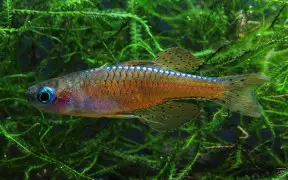
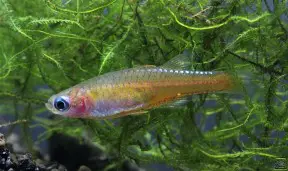
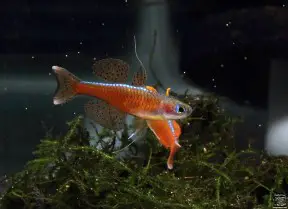
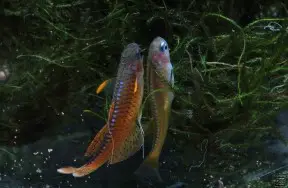
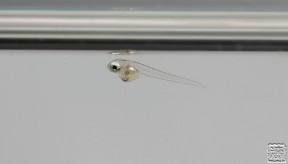
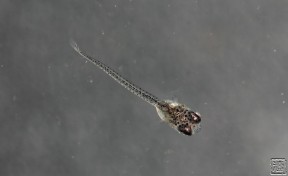
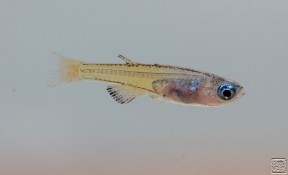
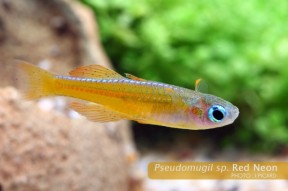
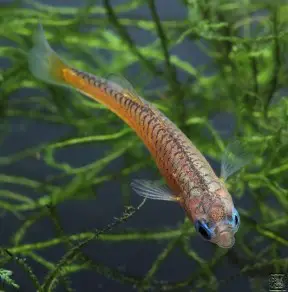

April 4th, 2013 at 9:02 pm
“The majority of fish available tend to be male, presumably due to their brighter colour pattern.” likely untrue, asian breeders would sell both sexes when available. The species however may have a natural bias toward more males, I get a much stronger bias with them than with p.gertrudae.
“This species is an egg-scatterer exhibiting no parental care and will consume its own eggs and fry given the opportunity.” now this is very true… these are actually far the worst egg-eaters among blue eyes.
Add a recommendation to check the mop several times per day.
It is easier to breed a small group (even a pair) than what you suggest because of egg-eating habits.
Add that the fry is not capable of taking artemia and needs perhaps 5 days of paramecium/powder food; however the rate of growth is very good comparing to other pseudomugils.
April 4th, 2013 at 9:10 pm
Photo 5 (mine, showing Red Egg) is for another species (pellicidus)… neon’s eggs are colorless and relatively small.
April 5th, 2013 at 8:33 am
All done except the recommendation to check mops daily as it was already there. :p
Much appreciated Mike, thanks again.
April 5th, 2013 at 3:05 pm
Very welcome.
On checking mop: nay it was not there! Daily is wrong IME. Correct is several times per day if you want to have enough eggs, they are this bad.
There are a couple of general problems with blue eyes profiles too:
1. 10-21 days range for hatching eggs: actually the timing depends on the species. It does not help to give a single interval to cover all species.. but if one does, it would be wider, perhaps 8-24. For red neons correct answer is “about 10 days”. For furcata, it is “about three weeks”. For tenellus and gertrudae it is about 10 days again. For signifer it depends on north/south, but 9-14 may be appropriate… Ivansoffi, reticulatus, pells are the longest. You see? Generally, fast developing eggs ==> small artemia incapable fry.
2. Recommended tankmates: again cannot copy this between profiles, and should be very careful with what you say. I’d be very afraid of putting threadfins with most blueeyes…threadfins are too delicate. otoh, large blue eyes (furcatus, southern sigs) can do fine with normal rainbows! I actually unintentionally kept Danio erythromicron with blue eyes .. raised the fry together, then forgot about the danios, they were hiding in the back of the tank for a few months, too afraid to come out 🙁 .. .not a thing I would recommend. Etc.
hth
April 5th, 2013 at 3:37 pm
Ok great, will make some changes now. 🙂
February 23rd, 2014 at 9:44 am
Pseudo by the way is greek…not latin
February 23rd, 2014 at 4:10 pm
Whoops, good point! Now fixed.
December 4th, 2017 at 1:41 pm
Guys, look at this paper 😉
Allen G.R., P.J. Unmack and R.K. Hadiaty (2016) Pseudomugil luminatus, A New Species of Blue-eye (Teleostei: Pseudomugilidae) From Southern New Guinea, With Notes on P. gertrudae. Fishes of Sahul 30(1): 950-961.